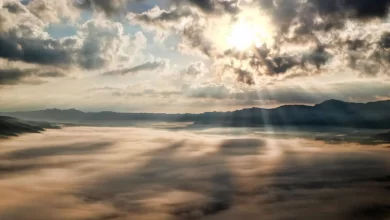Air is a complex mixture of gases and microscopic dust particles. It is the clear gas in which all living things breathe and live. In space, there is no air. Air is composed of approximately 78% nitrogen, 21% oxygen, 0.9 percent argon, 0.04 percent carbon dioxide, and trace amounts of other gases.
- The air we breathe contains more than 1,800 kinds of bacteria.
- At room temperature, the average air molecule travels at the speed of a rifle bullet.
- The air around is comprised of different gases like Nitrogen, Oxygen, Argon, Carbon Dioxide. The air also contains traces of helium, neon, methane, water vapours, hydrogen and krypton.
- The air is not just comprised of gases. It also contains tiny particles known as aerosols. Some of these particles occur naturally, like dust and pollen. Some of these particles are present due to manmade activities like smoke from cars, factories, or power plants.
- Humans consume around 50 liters of oxygen per hour and 16 kg of oxygen per day. Each plant leaf gives off about five milliliters of oxygen per hour.
- Dust, sandstorms, wildfires, and eruptions of volcanoes is the natural source of air pollution. Whereas the smoke from cars and other vehicles, smoke from factories and industries are the main manmade causes of air pollution.
- The air quality index is the thing to measure the quality of air. The higher the air quality index (AQI) value, the greater is the level of air pollution and the greater the health concern. For example, an AQI value of 50 or below represents good air quality, while an AQI value over 300 represents hazardous air quality.
- Air is not omini present and occupies space.
- Air can be compressed; compressing the air makes the molecules move more rapidly, which increases the temperature. This phenomenon is called as “heat of compression.” Compressing air is literally to force it into a smaller space, and as a result, the molecules of the air get tightly packed.
- One-fifth of air comprise of oxygen. The oxygen in the air helps in respiration as well as combustion.
- The ozone layer is made up of three oxygen atoms. It occurs naturally in small amounts in the upper atmosphere. The ozone layer protects the life on earth from the sun’s harmful ultraviolet radiation.
- Nitrogen, which is present in the air, is essential for the growth of plants and vegetation.
- The particles of air push in all directions and the force that is exerted is called air pressure.
- Our lungs hold one litter of air all the time, even if we exhale.
- The biggest air pollution instance was held in the year 1952 in London, England. It is known as the great smog of London, and it killed 8000 people. It was a combination of industrial pollution and high-pressure weather conditions, which lasted for five days.






